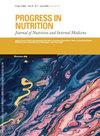Effects of Physalis peruviana and Lupinus albus on malondialdehyde, glutathione, cholesterol, vitamins and fatty acid levels in kidney and liver tissues of diabetic rats
4区 医学
Q4 Agricultural and Biological Sciences
引用次数: 4
Abstract
In this study, the effects of goldenberry and lupin on lipid peroxidation and antioxidant system parameters of liver and kidney tissues of streptozotocin-induced diabetic rats were investigated. Type II diabetes was produced in rats by the streptozotocin intraperitoneal injection. Albino rats were divided into four groups, each one containing 10 rats: non-diabetic control group, STZ-Diabetes type II group, STZ-Diabetes+goldenberry type II group, and STZ-Diabetes+lupin type II group. After one week from the injection, goldenberry and lupin were intraperitoneal injected to rats for 2 months. Malondialdehyde, glutathione, cholesterol, and fatty acid levels, which are signs of lipid peroxidation, were measured in these tissues. At the beginning and end of the study, postprandial blood glucose levels and weights of the rats were measured. In type II diabetes, malondialdehyde increased compared to the control group. Glutathione decreased in the other tissues and all of the streptozotocin-induced diabetic groups. In type II diabetes, liver cholesterol levels increased. Treatment with similar doses of goldenberry and lupin extracts significantly reduced postprandial hyperglycemia, oxidative stress, and augmented antioxidant system. The results of the present study showed that the herb suspensions exerted anti-hyperglycemic effects and consequently may alleviative liver and kidney damage caused by streptozotocin-induced diabetes.紫Physalis peruviana和Lupinus albus对糖尿病大鼠肾脏和肝脏组织丙二醛、谷胱甘肽、胆固醇、维生素和脂肪酸水平的影响
本实验研究了金梅和罗苹对链脲佐菌素诱导的糖尿病大鼠肝肾组织脂质过氧化和抗氧化系统参数的影响。腹腔注射链脲佐菌素致大鼠II型糖尿病。将白化病大鼠分为4组,每组10只:非糖尿病对照组、STZ-Diabetes 2型组、STZ-Diabetes 2型组、STZ-Diabetes 2型组、STZ-Diabetes 2型组和STZ-Diabetes 2型组。注射1周后,大鼠腹腔注射金枸杞和罗苹2个月。测量这些组织中丙二醛、谷胱甘肽、胆固醇和脂肪酸水平,这些都是脂质过氧化的迹象。在研究开始和结束时,测量了大鼠的餐后血糖水平和体重。在II型糖尿病患者中,丙二醛比对照组升高。谷胱甘肽在其他组织和所有链脲霉素诱导的糖尿病组中均下降。II型糖尿病患者肝脏胆固醇水平升高。用相似剂量的金莓和罗苹提取物治疗可显著降低餐后高血糖、氧化应激和增强抗氧化系统。本研究结果表明,中草药混悬液具有抗高血糖作用,可减轻链脲佐菌素所致糖尿病的肝肾损害。
本文章由计算机程序翻译,如有差异,请以英文原文为准。
求助全文
约1分钟内获得全文
求助全文
来源期刊

Progress in Nutrition
医学-营养学
CiteScore
1.40
自引率
0.00%
发文量
0
审稿时长
>12 weeks
期刊介绍:
Progress in Nutrition was founded in 1999 as an independent magazine, a multidisciplinary approach, dedicated to issues of nutrition and metabolism.
 求助内容:
求助内容: 应助结果提醒方式:
应助结果提醒方式:


